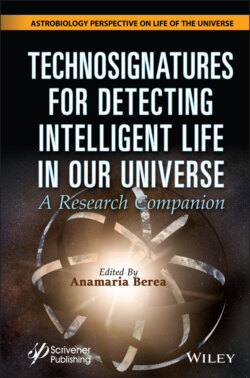Technosignatures for Detecting Intelligent Life in Our Universe

Реклама. ООО «ЛитРес», ИНН: 7719571260.
Оглавление
Группа авторов. Technosignatures for Detecting Intelligent Life in Our Universe
Table of Contents
List of Illustrations
Guide
Pages
Technosignatures for Detecting Intelligent Life in Our Universe. A Research Companion
Preface
1. Historical Perspectives: How the Search for Technosignatures Grew Out of the Cold War
1.1 Introduction
1.2 The Extraterrestrial Life Debate Gets Technical
1.3 Finding the 21-cm Hydrogen Line
1.4 The Role of the Space Race in Early CETI
1.5 Same Planet, Different Civilizations
1.6 Making Intelligent Life in the Universe
1.7 Conclusion: Returning to L
References
2. Reading the Cosmos: What Our Science Tells Us About the Science of Another World
2.1 Introduction
2.2 The Why and How of Interstellar Communication
2.3 An Early Language
2.4 A Language Based on Science
2.5 Our Senses, Our Perceptions and Our Science
2.5.1 Motion
2.5.2 Space “in the small”
2.5.3 Time
2.5.4 Space “in the large”
2.5.5 Mathematics
2.6 Conclusion
References
3. The Impact of Discovering the First Technosignature
3.1 Introduction
3.2 Cultural Impact Based on Analogous Historical Events
3.3 Modeling the Impact Based on the Discovery’s Diffusion into Society
3.4 Multimodal Diffusion into Knowledge Systems of Complex Publics
References
4. Searching for Extraterrestrial Intelligence by Locating Potential ET Communication Networks in Space
4.1 Introduction
4.2 Concepts
4.3 Case Study
4.4 Conclusions
Acknowledgements
References
5. Habitable Mini-Earths with Black Hole Cores
5.1 Introduction
5.2 Surface Comfort
5.3 Concept and Design
5.4 Surface Conditions and Size
5.5 Black Hole Core
5.6 Mass Boosting and Terraformation
5.7 Technosignatures
5.8 Conclusion
Acknowledgement
References
6. Technosignatures in Time-Series Photometry
6.1 Introduction
6.2 Types of Technosignatures. 6.2.1 Dyson Spheres
6.2.2 Transit Beacons
6.2.3 Orbital Mirrors
6.2.4 Lagrange-Point Starshades
6.2.5 Geostationary Artifacts
6.2.6 Laser Broadcasting and Planetary Cloaking
6.2.7 Non-Keplerian Orbits
6.3 Axis of Merit Discussion for These Technosignatures
6.4 Methods
6.4.1 Detectability of Time-Series Technosignatures
References
7. Post-Detection Message Analysis and Comprehension
7.1 Categorizing an ET Signal
7.1.1 Megastructures
7.1.2 Beamed Power and Propulsion Signals
7.1.3 Intercepted Communication
7.1.4 Intentional Communication
7.2 The Interstellar Communication Relay
7.3 The Processing Pipeline and Participants
7.4 Demodulation
7.4.1 Pulse Width Modulation
7.4.2 Pulse Interval Modulation
7.5 Combining Pulse Width and Pulse Interval Modulation. 7.5.1 Wavelength Multiplexing
7.5.2 Information Carrying Capacity
7.6 Data Extraction. 7.6.1 Transcription
7.6.2 Structural Analysis
7.6.3 Segmentation and Extraction
7.6.4 Data Types
7.6.5 Communicating Observables vs. Qualia
7.6.6 Images
7.6.7 Time Domain Signals
7.6.8 Algorithms (Computer Programs)
7.6.9 Solve For X Patterns
7.6.10 Memory
7.6.11 Modularity and Reuse
7.6.12 Symbolic Communication Systems and Artificial Languages
7.6.13 Genomic Information
7.6.14 Other Data Types
7.7 Classifying ETI Communication
7.7.1 Static/One Way Communication
7.7.2 Algorithmic Systems
7.7.3 Statically Defined Programs
7.7.4 Data-Driven Programs
7.7.5 Machine Learning/Narrow AI
7.7.6 Adaptive/Self-Learning Systems
7.8 Risks of Contact
7.8.1 Internal (Human Originated) Risks. 7.8.1.1 Interstate Competition and Interference
7.8.2 Misinformation
7.8.3 Societal Reaction
7.8.4 External Risks
7.8.5 Algorithms. 7.8.5.1 Malware
7.8.6 Artificial Intelligence
7.8.7 Genetic Information
7.8.8 Unknown Unknowns
References and Recommended Reading
8. Statistical Issues in the Search for Technosignatures
8.1 Introduction
8.2 General Issues
8.3 Emission Processes
8.3.1 Drake’s ND
8.3.2 Average Number of Emission Processes at Earth
8.4 Bayesian Inference from Non-Detection and Detection
References
9. Economics and Technosignatures: New Connections
9.1 The Different Faces of Economics
9.2 Economics in the Context of NASA Astrobiology Roadmap and the Drake Equation
9.3 Economics in the Context of Biosignatures vs. Technosignatures Research
9.4 Economic Methodology and Epistemology into Astrobiology
References
Index
Also of Interest. Check out these published and forthcoming related titles from Scrivener Publishing
WILEY END USER LICENSE AGREEMENT
Отрывок из книги
Scrivener Publishing
.....
Series Editors: Richard Gordon and Joseph Seckbach
In his 1687 book Principia, Isaac Newton showed how a body launched atop a tall mountain parallel to the ground would circle the Earth. Many of us are old enough to have witnessed the realization of this dream in the launch of Sputnik in 1957. Since then our ability to enter, view and understand the Universe has increased dramatically. A great race is on to discover real extraterrestrial life, and to understand our origins, whether on Earth or elsewhere. We take part of the title for this new series of books from the pioneering thoughts of Svante Arrhenius, who reviewed this quest in his 1909 book The Life of the Universe as Conceived by Man from the Earliest Ages to the Present Time. The volumes in Astrobiology Perspectives on Life of the Universe will each delve into an aspect of this adventure, with chapters by those who are involved in it, as well as careful observers and assessors of our progress. Guest editors are invited from time to time, and all chapters are peer-reviewed.
.....